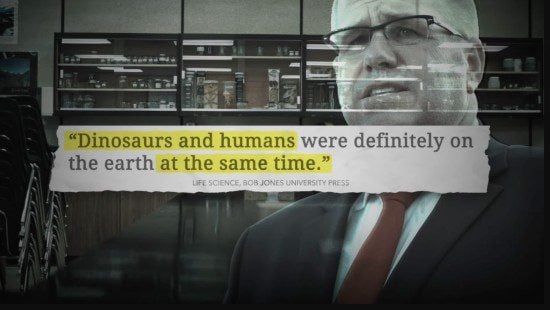Bob Jones University’s inaccurate, pernicious, and deliriously strange Christian school textbooks have become a factor in the governor’s race in Illinois. Incumbent Gov. J.B. Pritzker has begun running ads highlighting the use of that extremist curriculum in the private white fundamentalist Full Armor Christian Academy founded by his opponent, Republican candidate Darren Bailey.
BJU Press began publishing its textbooks as curriculum for segregation academies — the whites-only private religious schools that exploded throughout the country as white Christian parents recoiled in hysterical panic from Brown v. Board of Education, beginning their generations-long campaign to destroy public education. The main theme of BJU’s history textbooks was “Slavery Was Good, Actually,” and that theme was woven throughout its lessons in every discipline. Still is.
I know this firsthand because we used BJU’s “history” texts for a few years in the private white fundamentalist school I grew up in back in Central Jersey. Those dubious textbooks eventually got trashed — literally and figuratively — when the school hired a new history teacher, not realizing that his brand of Dutch Reformed Calvinism would clash with the anti-Reconstructionist cultural foundations of Bob Jones University’s segregationist religion.*
Alas, our school continued using BJU Press textbooks for our “Bible” class, and a major theme in their Bible textbook was also “Slavery Was Good, Actually.” Pretty sure they wove that theme throughout their Algebra textbooks too although, fortunately, we used a competent, “secular” textbook for that class.
The ad on Bailey’s school also points out the BJU textbooks’ Ken Ham-level young-Earth creationism. This includes teaching that “Dinosaurs and humans were definitely on the earth at the same time.”
Yes, Republican gubernatorial candidate Darren Bailey ran a school in which children were basically taught that The Flintstones was a documentary.
But don’t laugh. Well, OK, you’ve gotta laugh — the claim is hilariously wrong.
And it tends to backfire for fundies like Bailey and BJU Press and Ham. They like to emphasize dinosaurs because they realize that kids love dinosaurs, and so they enlist them to make the fantasy of young-Earth creationism more appealing to kids. The problem there is that, again, kids love dinosaurs. Those kids don’t see dinosaurs the way those adult fundies do — as a problem to be explained away in defense of an indefensible ideological claim. For those adults, dinosaurs are — like geology and astronomy and archaeology — challenges to be hastily dismissed with assurances that one needn’t think too much about them. But for those kids, dinosaurs are just cool. They’re way too cool to ignore or quickly dismiss, and so those kids devour everything they can to learn more about them.
Kids who have taught themselves to be pedantic sticklers over the difference between Triassic and Jurassic are gonna raise some questions when you try to tell them that Noah took baby dimetrodons on the ark.
But don’t only laugh, because Bailey’s Flintstones problem can’t be wholly separated from his Slavery Was Good, Actually problem. Those things are linked. Peel back the layers on any young-Earth creationist and you’ll find a slavery apologist.
It may be, in some individual cases, that you’ll find a reluctant and unwitting slavery apologist. Whole generations of white fundamentalist Christians in America were raised to believe that Ken Ham’s Flintstones malarkey was somehow a mandatory belief for anyone who wanted to revere the Bible as a sacred text. They ardently attempt to adhere to this teaching, even though it’s not easy to read the Bible (or any text) this way. And so they cling to young-Earth creationism and all of its attendant goofy nonsense — magical thinking about Noah’s flood, enthusiasm for cryptozoologist’s claims about the Loch Ness monster and Mokele-mbembe, an inordinate fondness for bombardier beetles, etc. — because they’ve been taught to believe that all of those weird accretions are necessary corollaries to their desire to regard the Bible as inspired scripture.
But the reflexive defense of slavery as “Good, Actually” isn’t one of those goofy additions. Nor is it just a coincidental correlation, some accident of time and circumstance arising from the happenstance of Darwin’s Origin of the Species arriving at roughly the same time as white Christianity was being threatened by the dangerous texts of the 13th, 14th and 15th Amendments.
The Flintstones garbage and the pro-slavery/pro-segregation garbage are linked more deeply than that. They both arise from the anti-hermeneutic of clobber-texting concordance-ism. Young-Earth creationism is an accidental side effect of this illiterate literalism. It’s what you get when you decide to read the book of Genesis in this way rather than reading it as as written or reading it as a book.
But the fierce defense of slavery, segregation, Redemptionism, and white-supremacy is not an accidental side effect. It is, rather, the purpose and function of this peculiar, anti-textual form of non-literal literalism. It is what the hermeneutic of white fundamentalism was designed for. White Christians in America taught themselves to read the Bible in this strange way and to reject every other way of reading the Bible because this was the only way to read it without encountering the irreconcilable conflict between American slavery and the Lord your God, who brought you out of Egypt, out of the land of slavery.
White fundamentalists embrace Answers in Genesis, in other words, because it’s the only way to avoid looking at the Answers in Exodus.
• The title of this post, of course, comes from the theme song for The Flintstones, which people my age remember from Saturday morning re-runs, but which originally ran as a prime-time sit-com from 1960-1966. Here’s a fine rendition of that theme song from Postmodern Jukebox.
– – – – – – – – – – – – –
* Our school also, briefly, used the Pensacola Bible College-produced Beka Books “science” textbook that became infamous online for including a photograph allegedly showing the Loch Ness Monster as “evidence” of a 6,000-year-old Earth in which dinosaurs and humans lived together.
Students revolted over that error-riddled textbook and helped to mock it out of use at the school. It wasn’t just the cryptozoology. Beka Books’ text also included things like a lesson on Galileo’s gravity experiment that suggested we could do the same thing by dropping a brick and a feather at the same time. So we interrupted class to do that, laughing loudly as the feather fluttered and swayed before, of course, eventually landing well after the brick. After that, it was open-season on our textbook — hands shooting up all over the classroom as we scoured its pages looking for more mistakes. The realization that a textbook might be wrong was, for a room full of middle-schoolers, exhilarating.
I suppose, in a way, I’m grateful to that Beka Books text for teaching me some important lessons, even if those lessons weren’t what it intended to teach. Alas, one of the lessons I learned from that experience was that it was sometimes effective to be a wise-ass, and perhaps that was a lesson I learned too well.













